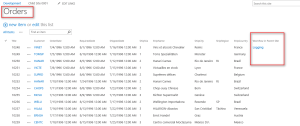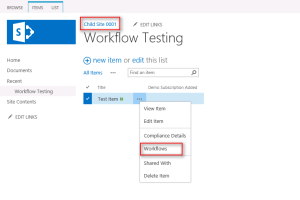Most Common SharePoint Interview
Question
1. What is SharePoint ?
Answer:
SharePoint is a web application platform in the Microsoft Office server suite
or SharePoint is a browser-based collaboration and document management platform
from Microsoft.
2. What
are Zones:
Answer:
Different logical paths (URLs meaning) of gaining access to the same SharePoint
web applications.
Five
Zones:
Internet
Intranet
Default
Extranet
Custom
3.
What is a Site Collection ?
Answer:
A site collection contains a top-level website and can contain one or more
sub-sites web sites that have the same owner and share administration settings.
4. What
are content databases ?
Answer:
A content database can hold all the content for one or more site collection.
5. What
is a site?
Answer:
A site in SharePoint contains Web pages and related assets such as lists, all
hosted within a site collection.
6.
What are Web
Applications in SharePoint?
Answer: An IIS Web site created and used by SharePoint 2010. Saying an IIS
virtual server is also an acceptable answer.
7. What is an application pool?
A group of one or more URLs that are served by a particular worker process or
set of worker processes.
8. Why are application pools important?
They provide a way for multiple sites to run on the same server but still have
their own worker processes and identity.
9. What are My Sites?
Specialized
SharePoint sites personalized and targeted for each user.
10. What is the difference between Classic mode authentication and
Claims-based authentication?
As the name implies, classic authentication supports NT authentication types
like Kerberos, NTLM, Basic, Digest, and anonymous. Claims based authentication
uses claims identities against a against a trusted identity provider.
11. What is Business Connectivity Services in SharePoint ?
SharePoint 2010 provides a new set of technologies known as Business
Connectivity Services for retrieving, editing,updating, and deleting data from
external systems(for e.g. data from ERP or CRM database). BCS enhances the
SharePoint platform’s capabilities with out-of-box features, services and tools
that streamline development of solutions with deep integration of external data
and services.
12. How is BCS Different from BDC in SharePoint ?
Even though the BDC made it relatively easy to create read-only solutions that
display data in the Business Data List Web Part, it was not so simple to create
a solution that enabled users to make changes and write that data back to the
external store.BCS, on the other hand, provides you with Read-Write capable
connectivity from Client and Server to Database, WCF/Web Services and .Net
Sources. A Developer can now use SharePoint Designer 2010 and VS 2010 rapid
development tools to access
external
data.
13. What is CAML?
CAML is Collaborative Markup Language.
it is a XML based
Language used in SharePoint Foundation to define fields and views used in sites
and lists.
14. What are Webparts?
By using web parts, you can modify the content, appearance, and behavior
of pages of a SharePoint site by using a browser. Web parts are
server-side controls that run inside a web part page: they're the
building blocks of pages that appear on a SharePoint site.
15. What is the
Lifecycle of Webpart?
Oninit
OnLoad
CreateChildControl
EnsureChilControl
SaveViewState
OnPreRender
Page.PreRenderComplete
Render
RenderContents
OnUnload
16. What is
Content Type Hub?
A Centralized site collection on which we will create all our site columns and
Content Types and through the Managed Metadata Service Application, these
Content Types can be used across our SPFarm. i.e., other site collections can
use these content types. Read More about Content Type Hub
17. What is
Cross Site Publishing?
Cross-site
publishing feature is used to store and maintain content in one or more
authoring site collections and display the content in one or more publishing
site collections.
18. What are the Step involved in
Configuring SSL Certificate
Create Self Signed
Certificate on IIS 8
Import Self Signed
Certificate to SharePoint Store
Add this Self
Signed Certificate to trust Management in CA
Configure IIS
Binding
Configure AAM
Settings.
19. What is
Minimal Download Strategy is SharePoint 2013 ?
Minimal Download
Strategy is a new technology in SharePoint 2013, which reduces the total amount
of Data that browser has to download, when user navigate from one page to
another page. When MDS is enabled, the client processes only the difference
between the current page and the requested page.
Example:
http://<your
site url>/_layouts/15/start.aspx#/SitePages/test.aspx
If MDS
is disabled, the above page URL will be
http://sp_site/SitePages/test.aspx
20. What
is Blob Cache?
Disk-based Caching
for Binary Large Objects
Disk-based caching controls caching for binary large objects (BLOBs) such as
image, sound, and video files, as well as code fragments. Disk-based caching is
extremely fast and eliminates the need for database round trips. BLOBs are
retrieved from the database once and stored on the Web client. Further requests
are served from the cache and trimmed based on security.
21.What are the
types of Mas ter Pages in SharePoint 2010
V4.master
Default.master
minimal.master
simple.master
22. Difference
between Farm solution and sandbox solution
Farm
Solutions:
· Hosted
in the IIS worker process (W3WP.exe), run code that can affect the
whole farm.
· If
you deploy any feature or retract any feature the whole application pool got
recycled.
- Since they are scoped as farm
level, they have full trust access to all the resources.
- When the Sand boxed Solution
property is set to False, selecting Build\Deploy will deploy the
solution to the Farm Solution Gallery.
- Farm solutions are installed and
deployed
Sandboxed Solutions:
- Sand boxed solutions are hosted in
the SharePoint user code solution worker process (SPUCWorkerProcess.exe).
- It never restart the IIS
application pool
- Scoped at Site collection
level
- When the Sandboxed Solution
property is set to True, selecting Build\Deploy Solution deploys
the solution to the site collection Solution Gallery.
- Sandboxed solutions are uploaded
and activated.
- We can't create Application pages
in Sandbox solutions.Beacuse Application pages are stored in the
14\TEMPLATES\_LAYOUTS and when we deploy as sandbox we don’t have
permissions to the physical folder.
- We can’t create VISUAL web parts
in Sandbox solutions.
- We can’t use code to connect to
the external web services or to database
- Visual Studio attaches the
debugger to the SPUCWorkerProcess process that the SPUserCodeV4 service in
SharePoint automatically triggers and controls
23. Steps
for configuring incoming outgoing email setting
Install the SMTP
service
Configure the SMTP
service
Set the SMTP
service to start automatically
Configure outgoing
email for a farm by using Central Administration
Configure Incoming.
24. what is the
difference between Site template and site defination
Site Template :
The first option for getting the SharePoint Designer changes beyond the current
site is to take the site you have modified with SharePoint designer and save it
as a template. You can download the template and upload this to another site
collection and can create a site based on this template. Whenever you need a
new site you can create it from the site template you have created.
Site Defination :
Site Definitions are the foundations on which all sites and user templates are
built.
Site Definition is collection ox XML and
.aspx file.
Site Definitions are predefined components
needs to be included when a site was created inSharePoint server.
Site Definition contains information of Web
Part , Lists, Features and navigation bars to be included in the site.
25.
Powershell command for Backup and Restore
Restore-SPSite
-Identity http://dotnetsharepoint
-path C:\TestBackup.bak
26. Steps
for SharePoint Installation
1. Run Microsoft SharePoint product preparation tool
(After
you complete SharePoint Product preparation tool, you can also install Patches)
2. Run
Setup which will install MS SQL Server 2008 R2 SP1 Express Edition, and
Sharepoint Product.
3. Run
Microsoft SharePoint Configuration Wizard, that will install configuration
database, content database, SharePoint Central Administration website and it
will also install your first Sharepoint Website.
4.
Configure Browser Setting
5.
Perform Post-Installation Steps.
27. Steps for SharePoint Migration from SharePoint 2010 to SharePoint 2013?
1. Create the SharePoint 2013 farm and configure and tests the environment.
Installs the new SharePoint 2013 farm and configure and tests the new environment. Set the SharePoint 2010 Farm to Read Only, so that user continue to have access to the old farm during the upgrade process on the new farm.
2. Copy the SharePoint 2010 Product DB.
Backup the Read Only Content DB, Service DB and Config DB on SharePoint 2010 Farm.
Restore a copy of the DB to SharePoint 2013 Farm and sets the DB to Read Write Mode.
3. Upgrade the Product DB and Service Application DB
Configure Service application and Web Application and install all the customization in the old farm to the new farm and then Upgrade the Content DB by using the power shell Command Mount -SPContentDatabase.
Upgrade of DB is Successful.
4. Upgrade the SharePoint Site Collection.
Site owner is the in charge of upgrade on the site collection
27.
What is managed metadata?
Managed
Metadata is a hierarchical collection of centrally managed terms that you can
define, and then use as attributes for items in SharePoint 2013.
28.
Powershell Command for Backup and Restore Subsite
Export-SPWeb
http://dotnetsharepoint.com/sites/dotnet/dotnetsharepoint/ –Path
"C:\BackUp\DotNetSharePoint.cmp" -includeusersecurity
Import-SPWeb
http://dotnetsharepoint.com/sites/dotnet/sharepoint/ -Path
"C:\SiteBackUp\DotNetSharePoint.cmp" -IncludeUserSecurity
-Force
28. What
is Distributed Cache service
The
Distributed Cache service provides caching features in SharePoint Server 2013.
The microblog features and feeds rely on the Distributed Cache to store data
for very fast retrieval across all entities. The Distributed Cache service is
built on Windows Server AppFabric, which implements the AppFabric Caching
service. Windows Server AppFabric installs with the prerequisites for
SharePoint Server 2013.
The Distributed
Cache service, which is built on Windows Server AppFabric Cache, is
set to run in a collocated mode on all SharePoint 2013 Servers by default,
using up to 10% of the server's total physical memory.
29.
What are Device Channels in SharePoint 2013
Ans: With device channels in SharePoint 2013, you can render a single
publishing site in multiple ways by using different designs that target
different devices for example mobile devices etc.These device channels can each
be given a different master page and CSS file to give users a more optimal
viewing experience.For more Info see Plan
device channels in SharePoint Server 2013
30. What are the Search Components?
Answer :
Search
component name
|
Description
|
Crawl component
|
Crawls content sources to collect
crawled properties and metadata from crawled items and sends this information
to the content processing component.
|
Content processing component
|
Transforms the crawled items and
sends them to the index component. This component also maps crawled
properties to managed properties.
|
Analytics processing component
|
Carries out search analytics and
usage analytics.
|
Index component
|
Receives the processed items from
the content processing component and writes them to the search index. This
component also handles incoming queries, retrieves information from the
search index and sends back the result set to the query processing component.
|
Query processing component
|
Analyzes incoming queries. This
helps optimize precision, recall and relevance. The queries are sent to the
index component, which returns a set of search results for the query.
|
Search administration component
|
Runs the system processes for
search, and adds and initializes new instances of search components.
|
31. What are the Search Databases?
Answer
Search database name
|
Description
|
Crawl
database
|
Stores
tracking information and historical information about crawled items such as
documents and URLs. It also stores information such as the last crawl time,
the last crawl ID and the type of update (add, update, delete) during the
last crawl.
|
Link
database
|
Stores
unprocessed information that is extracted by the content processing component
and information about search clicks. The analytics processing component
analyzes this information.
|
Analytics
reporting database
|
Stores
the results of usage analysis.
|
Search
administration database
|
Stores
search configuration data.
|









